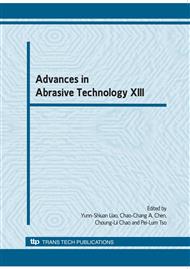p.879
p.885
p.891
p.899
p.905
p.911
p.917
p.923
p.929
Effect of Aged AlN Reinforced Al-Si Alloys on Dry Sliding Wear Behaviour
Abstract:
Dry sliding wear properties of aluminum nitride (AlN) reinforced aluminum silicon (Al-Si) alloy were investigated by using a pin-on-disc configuration tester. In this work, different weight percentages (5 and 10 wt%) of AlN was added into the Al-Si alloys. The samples were prepared by a stir casting process via a bottom pour technique which was then aged with a T6 condition prior to the wear test. Detailed analyses on the morphologies were conducted using scanning electron microscope (SEM) with the aid of an energy dispersive x-ray analyser (EDX). Prior to the heat treatment, the distribution of hard aluminum nitride particles that surrounded the Si phase had improved the hardness of the composites by 15%. The hardness value was found to be significantly increased about 80% for aged samples compared to un-aged samples. This was mainly contributed from precipitations of Si grain and intermetallic compounds; Mg2Si and FeSiAl5 formation in the alloys. Thus, a significant increased in wear resistance up to 56% was also observed especially at the highest applied load of 70N. Surface investigation by a scanning electron microscope (SEM) revealed that a combination of abrasion and adhesion wear mechanism was dominant for both un-aged and aged samples.
Info:
Periodical:
Pages:
905-910
Citation:
Online since:
August 2010
Price:
Сopyright:
© 2010 Trans Tech Publications Ltd. All Rights Reserved
Share:
Citation:


